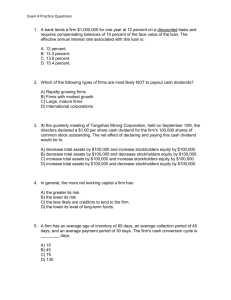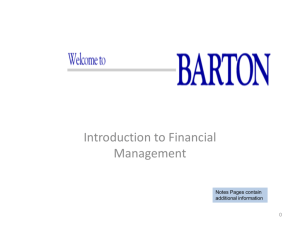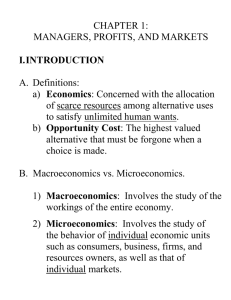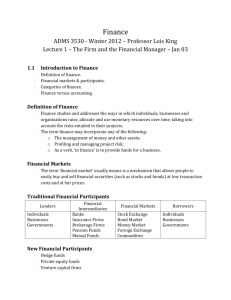Essentials of Finance
advertisement
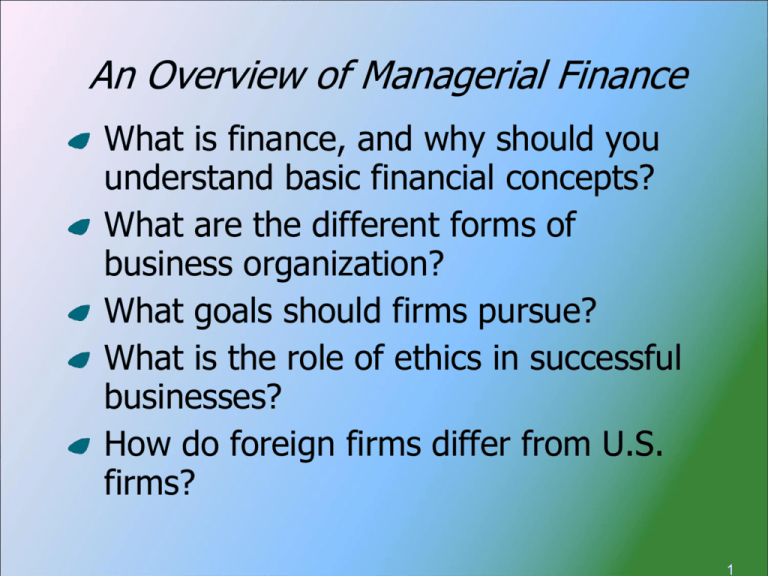
An Overview of Managerial Finance What is finance, and why should you understand basic financial concepts? What are the different forms of business organization? What goals should firms pursue? What is the role of ethics in successful businesses? How do foreign firms differ from U.S. firms? 1 What is Finance? Finance deals with decisions concerning cash inflows and cash outflows. Emphasis is on cash flows rather than income because most liabilities—that is, debts—must be paid with cash. Everything else being equal: More value is preferred to less. The sooner cash is received the more value it has. Less risky assets are more valuable than riskier assets. 2 Importance of Managerial Finance in Nonfinance Areas Most business decisions cannot be made without considering the impact on the financial well-being of the firm. Must determine whether the funds needed to implement decisions are available. 3 General Areas of Finance Financial Markets and Institutions Investments Financial Services Managerial Finance 4 General Areas of Finance Financial Markets and Institutions Relates to the financial markets and the participants in these markets 5 General Areas of Finance Investments Involves evaluating financial assets to determine which investments to include in a portfolio of financial assets. 6 General Areas of Finance Financial Services Refers to functions provided by organizations in the finance industry, including services that help individuals (and companies) determine how to invest money to achieve such goals as retirement and financial stability. 7 General Areas of Finance Managerial Finance Involves decisions regarding investments in real assets, such as plant and equipment, (investing decisions) and how such investments should be financed (financing decisions). 8 Alternative Forms of Business Organization Proprietorship Partnership Corporation Hybrid Forms of Business 9 Proprietorship—70%-75% Advantages: easy and relatively inexpensive to form affected by few regulations business is taxed as an individual Disadvantages unlimited personal liability firm’s life is limited ownership transfer can be difficult firm’s credit and its ability to raise funds 10 Partnership—about 10% Advantages: easy and relatively inexpensive to form affected by few regulations business is taxed as an individual Disadvantages unlimited personal liability firm’s life is limited ownership transfer can be difficult firm’s credit and its ability to raise funds—better than for a proprietorship 11 Corporation—15%-20% Advantages: limited liability unlimited life easy transfer of ownership ease of raising capital Disadvantages: cost of set-up and filing financial reports double taxation 12 Hybrid Forms of Business Limited Liability Partnership (LLP) some partners have limited liability must be one general partner Limited Liability Company (LLC) taxed like a partnership, but owners have limited liability flexible ownership structure S Corporation fewer than 100 stockholders taxed like a partnership 13 Goals of the Corporation Maximize wealth Should be the primary goal of the financial manager. Social Responsibility Firms should be socially responsible at the same time they earn “normal” profits. Wealth Maximization & Social Responsibility Actions that maximize the value of the firm also are beneficial to society; wealth maximization improves the standard of living. 14 Agency Relationships An agency relationship exists when owners do not manage the firm’s day-to-day operations. An agency “problem” exists if managers attempt to satisfy interests that differ from the best interests of the firm’s owners. Two important agency relationships that exist are between managers and stockholders and stockholders and creditors. 15 Stockholders versus Managers An agency problem is possible if owners do not run the company. An agency problem can be mitigated by the following means: threat of firing takeover threat reward managers for acting in the best interests of owners make managers owners 16 Stockholders versus Creditors If stockholders approve actions that harm the positions of the firm’s creditors, it is likely that the firm will find it difficult to borrow funds in the future. 17 Business Ethics Webster: “A standard of conduct and moral behavior.” Business Ethics: A company’s attitude and conduct toward its employees, customers, community, and investors (debt holders and stockholders) 18 Corporate Governance The “set of rules” that a firm follows when conducting business As a result of the Sarbanes-Oxley Act of 2002, firms are revising their corporate governance policies Good corporate governance generates higher returns to stockholders 19 Forms of Business in Other Countries (Foreign Companies) Most businesses that are based outside the United States are “closed” organizations in the sense that they have more concentrated ownership—that is, fewer owners. 20 Multinational Corporations Firms go “international” to seek new markets seek raw materials seek new technology seek production efficiency avoid political and regulatory hurdles 21 Factors that Distinguish Domestic Firms from Multinational Firms different currency denominations economic and legal ramifications language differences cultural differences government involvement political risk 22 An Overview of Managerial Finance What is finance? Finance deals with decisions about money What are the forms of business organization? Proprietorship, partnership, corporation What goals should firms pursue? Maximize stockholder’s wealth What is the role of ethics in business? “Ethical firms” survive; “non-ethical firms” do not How do foreign firms differ from U.S. firms? Non-US firms have more concentrated ownership 23



